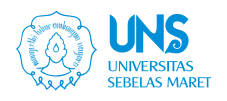RELIGIOUS MODERATION IN ART: A COMPARATIVE STUDY BETWEEN SURAKARTA AND CAIRO
Abstract
This study explores the perceptions of art students in Surakarta regarding religious moderation in artistic expression and compares them with the context in Cairo through a literature review. The research employs a qualitative method with a literature-based approach and thematic analysis techniques. The analysis integrates Talcott Parsons' AGIL theory (adaptation, goal attainment, integration, and latency) and Dahrendorf's conflict theory to examine the tension between freedom of expression and social norms. Religious elements in art often spark controversy, especially in culturally diverse regions like Surakarta. The study aims to understand how future artists view and incorporate religious values into their work. Participants were purposively selected, considering religious diversity and artistic experience. Findings reveal that art students in Surakarta view religious moderation as an effort to create harmony in art, despite challenges in balancing religious values and creative freedom. Using AGIL theory, the study identifies students' adaptation to religious values, their goal to produce inclusive art, integration of artistic freedom with religious norms, and the latency of internalizing moderation values. Meanwhile, Dahrendorf's conflict theory highlights social tensions influencing students' creative processes. The literature review on Cairo underscores religious moderation as a foundation for social harmony, with Al-Azhar University exemplifying tolerance through religious education. This research contributes to the academic field by offering deeper insights into the relationship between art, religion, and religious moderation. It provides practical guidance for art institutions to develop inclusive and harmonious art practices in diverse cultural and religious contexts.
Keywords
Full Text:
PDFReferences
AC. (Informant), Interviewed on July18, 2024. Surakarta.
Aini, Huril, Misbachol Munir, and Nida’ul Munafiah. 2023. “Peran Kampus Sebagai Wadah Pencetak Generasi Moderasi Beragama.” Wahana Karya Ilmiah Pendidikan 7(02):95–103. DOI: https://doi.org/10.35706/wkip.v7i02.10056
Al-Zadjali, Zahra. 2024. “The Significance of Art in Revealing a Culture’s Identity and Multiculturalism.” Open Journal of Social Sciences 12(01):232–50. DOI: https://doi.org/10.4236/jss.2024.121015
Anam, Ahmad Muzakkil. 2019. “PENANAMAN NILAI-NILAI PENDIDIKAN ISLAM MULTIKULTURAL DI PERGURUAN TINGGI KEAGAMAAN ISLAM (Studi Kasus Di Universitas Islam Malang).” Journal ISTIGHNA 2(2):12–27. DOI: https://doi.org/10.33853/istighna.v2i2.24
Arifin, Muh. Luqman, Fauzi, Muh. Gitosaroso, Muhamad Basitur Rijal, and Mahmudin. 2021. “Geneologi Keilmuan Ponpes Darussalam Gontor Dengan Universitas Al-Azhar Cairo.” TADRIS: Jurnal Pendidikan Islam 16(2):351–63. DOI: https://doi.org/10.19105/tjpi.v16i2.4836
BL. (Informant), Interviewed on June 28, 2024. Surakarta.
Chapman, Susan Narelle and Lyndal O’Gorman. 2022. “Transforming Learning Environments in Early Childhood Contexts Through the Arts: Responding to the United Nations Sustainable Development Goals.” International Journal of Early Childhood 54(1):33–50. DOI: https://doi.org/10.1007/s13158-022-00320-3
Clarke, Peter B. 2009. The Oxford Handbook of the Sociology of Religion. edited by P. B. Clarke. Oxford University Press.
Dahrendorf, Ralf. 2018. Class and Class Conflict in Industrial Society. Forgotten Books.
Damodaran, A. 2024. “From Non Fungible Tokens to Metaverse: Blockchain Based Inclusive Innovation in Arts.” Innovation and Development 14(2):383–402. DOI: https://doi.org/10.1080/2157930X.2023.2180709
Dayem, Fatimah Gamal Abdel, Abdul Fikri, Sutrisno, and Mohammad Joko Susilo. 2024. “Analisis Kebijakan Pendidikan Islam Di Al-Azhar, Mesir Pada Era Kontemporer 1,2.” Buletin Edukasi Indonesia (BEI) 3(01):27–37. DOI: https://doi.org/10.56741/bei.v3i01.519
Eltayeb, Mohamed Saeed M. 2010. “The Limitations on Critical Thinking on Religious Issues under Article 20 of ICCPR and Its Relation to Freedom of Expression.” Religion & Human Rights 5(2–3):119–35. DOI: https://doi.org/10.1163/187103210X528147
Fadhil, Andi and Abd Rahman. 2023. “MODERASI BERAGAMA : STUDI KOMPARASI PANDANGAN AL-AZHAR DAN KEMENTRIAN AGAMA.” 14(September):149–61. DOI: https://doi.org/10.25078/sjf.v14i2.2560
Gumuruh, Andika Ronggo. 2023. “Religious Moderation in The Context of Pancasila: A Study of Role and The Impact Is Deep Maintaining Social Harmony.” Islamika Inside: Jurnal Keislaman Dan Humaniora 9(1):1–19. DOI: https://doi.org/10.35719/islamikainside.v9i1.243
HA. (Informant), Interviewed on June 8, 2024. Surakarta.
Hasibuan, Kalijunjung. 2023. “MODERASI BERAGAMA BERBASIS KELUARGA.” SENTRI: Jurnal Riset Ilmiah 2(11):4655–66. DOI: https://doi.org/10.55681/sentri.v2i11.1777
Kaelan. 2012. Metode Penelitian Kualitatif Interdisipliner. Yogyakarta: Paradigma.
Kemenag. 2020. Panduan Moderasi Beragama. 1st ed. Jakarta: Kementerian Agama.
Khamim, Siti, Zulfani Sesmiarni, Nuryanti Siregar, Helmi Rostiana Dasopang, and Afni Lindra. 2024. “Optimalisasi Pendidikan Agama Islam Untuk Mendorong Internalisasi Nilai Moderasi Di Perguruan Tinggi Umum (Studi Pada Institut Administrasi Dan Kesehatan Setih Setio Muara Bungo).” NUR EL-ISLAM : Jurnal Pendidikan Dan Sosial Keagamaan 10(2):376–404. DOI: https://doi.org/10.51311/nuris.v10i2.524
Mazzone, Marian and Ahmed Elgammal. 2019. “Art, Creativity, and the Potential of Artificial Intelligence.” Arts 8(1):26. DOI: https://doi.org/10.3390/arts8010026
Němec, Damián. 2023. “Juridical Relations between Freedom of Artistic Expression and Protection of the Dignity of Religion in the Light of a Lawsuit over Theatrical Performances in the Czech Republic.” Philosophy and Canon Law 9(2):1–32. DOI: https://doi.org/10.31261/PaCL.2023.09.2.06
Nikolenko, Kseniia, Lesia Romaniuk, Petro Luno, Marina Barbash, and Tetiana Kornisheva. 2024. “The Role of Art in the Social Integration of Refugees in Multicultural Societies.” Revista Amazonia Investiga 13(76):308–22. DOI: https://doi.org/10.34069/AI/2024.76.04.25
Rofiq, Ainur. 2024. “KOMUNIKASI FORUM KERUKUNAN UMAT BERAGAMA SEBAGAI PERWUJUDAN MODERASI BERAGAMA DI KABUPATEN BANYUWANGI.” Jurnal Al-Tsiqoh 8(2):50–78. DOI: https://doi.org/10.31538/altsiq.v8i2.4863
RS. (Informant), Interviewed on July 18, 2024. Surakarta.
Sugiyono. 2018. Metode Penelitian Kualitatif. Bandung: Alfabeta.
Sumarto, Sumarto and Emmi Kholilah Harahap. 2021. “Pemahaman Nilai – Nilai Moderasi Beragama Dan Kebangsaan Melalui Kegiatan Diklat Kementerian Agama RI Dalam Muwujudkan ASN Moderat Studi Di Balai Diklat Keagamaan BDK Palembang.” Jurnal Literasiologi 7(1). DOI: https://doi.org/10.47783/literasiologi.v7i1.271
VK. (Informant), Interviewed on June 19, 2024. Surakarta.
Talcott, Parsons and Bryan S. Turner. 2013. The Social System.
Tinambunan, Edison R. L., I. Ketut Gegel, Peter Bruno Sarbini, and Gus Zain Baik. 2025. “Implication Abu Dhabi Document: To Build Religious Moderation with Brotherhood-Sisterhood and Friendship in Indonesia.” Cogent Arts & Humanities 12(1). DOI: https://doi.org/10.1080/23311983.2025.2451514
Yusup, Ikhsanudin and Warli Haryana. 2022. “PENCIPTAAN GAMBAR ILUSTRASI DARI NILAI NILAI MODERASI BERAGAMA.” Acintya : Jurnal Penelitian Seni Budaya 14(1):48–52. DOI: https://doi.org/10.33153/acy.v14i1.4300
ZC. (Informant), Interviewed on June 11, 2024. Surakarta.
Zuldafrial. 2012. Penelitian Kualitatif. Yogyakarta: Media Perkasa.
Refbacks
- There are currently no refbacks.













